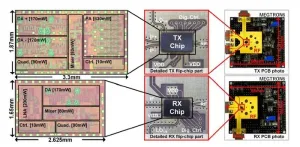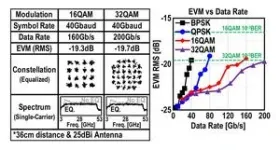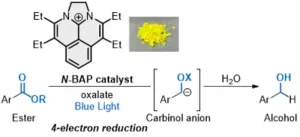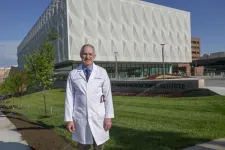(Press-News.org)
A new D-band CMOS transceiver chipset with 56 GHz signal-chain bandwidth achieves the highest transmission speed of 640 Gbps for a wireless device realized with integrated circuits, as reported by researchers from Tokyo Tech and National Institute of Information and Communications Technology. The proposed chipset is highly promising for the next generation of wireless systems.
To achieve faster speeds and handle increasing data traffic, wireless systems are operating in higher millimeter-wave frequency bands. Current high-band 5G systems offer speeds as high as 10 Gbps and operate in frequency bands between 24–47 GHz. The next generation of mobile communication systems, is exploring even higher frequency bands.
Within this spectrum, the D-band, covering frequencies from 110 to 170 GHz, is expected to play a crucial role in the development of next generation of wireless systems. While high frequencies provide faster data speeds, they are susceptible to attenuation. Therefore, for the widespread adoption of next generation of wireless systems, cost-effective transmitters and receivers capable of maintaining signal strength are crucial.
Recently, Professor Kenichi Okada and his team at Tokyo Institute of Technology, in collaboration with National Institute of Information and Communications Technology (NICT), Japan, have developed a novel transceiver chipset for the D-band. This chipset is fabricated using the widely-used 65nm silicon Complementary Metal-Oxide-Semiconductor (CMOS) process, making it cost-effective for mass production. The research results will be presented at the 2024 IEEE Symposium on VLSI Technology & Circuits, June 16–20 in Honolulu, USA.
Okada remarks, “Notably, the world's highest wireless transmission rate of 640 Gbps is achieved using low-cost CMOS technology.”
This work presents a D-band (114–170 GHz) CMOS transceiver chipset covering a 56 GHz signal-chain bandwidth. The transceiver, with a chip size of 1.87 mm x 3.30 mm for the transmitter integrated circuit (IC) and 1.65 mm x 2.60 mm for the receiver IC, uses components designed to maintain signal speed and quality across a broad frequency spectrum (refer to Figure 1). These include power amplifiers for elevating signals to suitable levels, low-noise amplifiers for boosting signal strength while minimizing noise, frequency converters (mixers) for adjusting signals to the desired frequency range, distributed amplifiers for linearity, and frequency multipliers for quadrupling the frequency.
To assess the wireless transmission capabilities, the researchers mounted the chipset on a PCB and connected it to an external antenna with a gain of 25 dBi. The signal was converted from a transmission line format, typically used on PCBs, to a waveguide format, used for high-frequency signal transmission in wireless applications, with the conversion loss kept to 4 dB. With the new chipset, the researchers achieved high linearity for multi-level modulation schemes like 16QAM and 32QAM (QAM: Quadrature Amplitude Modulation), solving a major roadblock for IC transceivers (check Figure 2).
In testing with a modulated signal with a symbol rate of 40 Gbaud and 32QAM modulation at a distance of 36 cm, the system achieved a transmission speed of 200 Gbps with high modulation accuracy, with a bit error rate of less than 10-3. Furthermore, using 16QAM modulation and a high-gain antenna (with a gain of 43 dBi), the researchers were able to achieve speeds of 120 Gbps over a distance of 15 m (as shown in Figure 3).
The chipset’s performance was further impressive in a multiple-input multiple-output configuration with four transmitters and four receiver modules. Here, each antenna can handle its own data stream, enabling fast communication. Using 16QAM modulation, each channel reached a speed of 160 Gbps. Overall, this resulted in a total speed of 640 Gbps.
These speeds represent a significant leap, being 10 to 100 times faster than current 5G systems. Okada concludes: “The proposed chipset holds promise for the next generation of wireless systems to support automated cars, telemedicine, and advanced virtual reality experiences.”
This work is partially supported by the Ministry of Internal Affairs and Communications in Japan (JPJ000254).
###
About Tokyo Institute of Technology
Tokyo Tech stands at the forefront of research and higher education as the leading university for science and technology in Japan. Tokyo Tech researchers excel in fields ranging from materials science to biology, computer science, and physics. Founded in 1881, Tokyo Tech hosts over 10,000 undergraduate and graduate students per year, who develop into scientific leaders and some of the most sought-after engineers in industry. Embodying the Japanese philosophy of “monotsukuri,” meaning “technical ingenuity and innovation,” the Tokyo Tech community strives to contribute to society through high-impact research. https://www.titech.ac.jp/english/
END
Peer-reviewed – Qualitative study - Humans
A new study has provided an in-depth look into the rising trend of disposable vape use among young people in the UK.
The research, led by the University of East Anglia, reveals that young people see smoking and vaping as interchangeable, but are far more aware of the potential harms of vaping than they are of the dangers of smoking.
The findings also suggest that banning disposable vape products or increasing their prices could lead young people to revert to smoking tobacco.
Many of the young people questioned also believed that ...
Atlanta, Ga.—Eczema, a skin inflammatory disease that causes dry, itchy and inflamed skin, affects millions worldwide. Eczema is associated with an altered skin microbiome and higher colonization by Staphylococcus aureus. The study, led at New York Medical by postdoctoral fellow Anish R. Maskey, Ph.D., focuses on the natural compound berberine and its impact on eczema exacerbated by S. aureus. The findings, presented at ASM Microbe, shed light on berberine’s ability to inhibit S. aureus colonization and alleviate eczema symptoms without adverse effects.
Current ...
A data-driven intervention that engaged communities to rapidly deploy evidence-based practices to reduce opioid-related overdose deaths – such as increasing naloxone distribution and enhancing access to medication for opioid use disorder – did not result in a statistically significant reduction in opioid-related overdose death rates during the evaluation period, according to results from the National Institutes of Health’s HEALing (Helping to End Addiction Long-Term) Communities Study. Researchers identified the COVID-19 pandemic and increased prevalence ...
Atlanta, GA – New research has shed light on the effects of protein-rich diets on the gut microbiome and overall health. Despite the increasing protein intake in Western diets, especially among athletes and individuals with obesity, the fate of undigested protein and its impact on human health remains largely unknown. A new study, presented at ASM Microbe, explores how excess undigested protein in the colon can be fermented to produce beneficial metabolites, such as short-chain fatty acids (SCFAs), or lead to the production of harmful metabolites like ammonia and sulfides, which are linked to gastrointestinal disorders and other health issues.
The research team conducted a series of experiments ...
Highlights:
Mouse studies suggest a link between the gut microbiome and neurodegenerative diseases, but the pathways remain unclear.
New study reports distinct bacterial and metabolite profile in patients with Alzheimer’s disease and other neurodegenerative diseases.
The study flagged the metabolite DHPS as a possible missing link in our understanding of how gut microbes influence NDDs through sulfur metabolism pathways.
Atlanta, Ga.—Neurodegenerative diseases (NDDs), which have no known cures and elusive causes, result in irreversible damage to the brain and nervous system. Research into these diseases typically focuses on the brain, but mouse ...
TLS are accumulations of lymphoid cells that share similar cellular compartments, organization, and function as secondary lymphoid organs. Importantly, the presence of these structures in inflamed salivary glands associated with active disease, increased autoantibody production, and malignancy risk.
“To treat patients effectively, comprehensive understanding of the salivary gland microenvironment is needed”, said Saba Nayar, “but current profiling efforts often struggle to capture high-plex 'omics data while preserving the spatial architecture of the tissue.”
To ...
The 16-week Plants for Joints trial investigated the effects of a multidisciplinary lifestyle intervention in people with RA, as compared to usual care. The intervention was based on a whole-food, plant-based diet – alongside physical activity and stress management. Previous reports showed this intervention significantly reduced the 28-joint disease activity score (DAS28) compared to usual care alone.2,3 To expand on this, the researchers wanted to determine the long-term effectiveness of the intervention, specifically with ...
The volatile of isoamyl alcohol released from the stored wheat increased with the storage extending, making it one of the potential biomarkers for the early-stage of wheat mildew. Currently, there is a scarcity of chemiresistors for isoamyl alcohol detection, which suffer from low sensitivity. The team of material scientists led by Professor Chao Zhang reported that LaFeO3-based sensing materials demonstrated remarkable sensitivity for isoamyl alcohol (DOI: 10.1039/D3TA05718F, 10.1007/s11666-024-01740-4). However, it’s essential to note that there is still potential for lowering the optimal operating temperature and enhancing moisture ...
The sweet smell of strawberries and other fruits is thanks to a chemical compound called ester, which is also found in many fats and polyesters. The ubiquitous compound can be broken down to produce desirable alcohols and other chemicals for use across industries including pharmaceuticals and cosmetics, but the process can be costly, both financially and in terms of the environment.
Now, a team of researchers with the National Institutes of Natural Sciences (NINS) in Japan has developed a novel approach using light as an energy ...
As temperatures rise, so do chances for migraine attacks, according to a new study from a team of researchers at the University of Cincinnati College of Medicine, Icahn School of Medicine at Mount Sinai, Errex Inc. and Teva Pharmaceuticals USA. Inc.
“Weather change is one of the most common trigger factors for migraine,” says Vincent Martin, MD, director of the Headache and Facial Pain Center at UC's Gardner Neuroscience Institute and UC Health physician. He is the study’s lead author and president of the National Headache Foundation.
These findings from the study, which looked at use of Fremanezumab and whether it could prevent headaches ...





